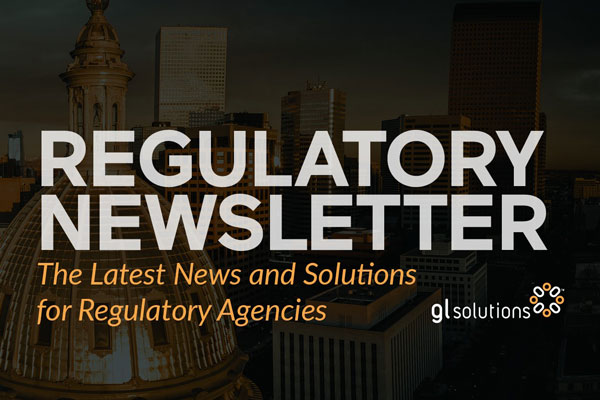6 Agency Modernization Questions You Must Ask
Your regulatory agency heard the call to modernize, receiving cash from the federal government to improve your outdated licensing systems. As a regulatory agency leader, ask yourself the following questions to guide your modernization efforts. Then use your answers, along with our action items, to help pave the way towards the transformation of your agency.
1. What is the purpose of your regulatory agency?
The purpose of your agency represents the heart of your agency, fueling your mission and your vision. Consider the purpose of your agency whenever you face an important decision; your purpose helps you align your agency’s ideals with your agency’s objectives.
Action item: Focus on developing your mission and vision. Frank Migali, Executive Director of the Arizona Barbering and Cosmetology Board, explains his journey defining his agency’s mission, along with the importance of taking that step. “I spent a year really focusing on developing a mission and vision for the organization and most importantly our vision—and getting the buy in,” Migali explains. “So first and foremost, it’s super important for me to have the buy in from my team or teams to that vision. Because that’s what really gets people to come alongside; and when people come alongside, they’re willing to identify problems. They’re willing to help solve those problems.”
2. What changes need to happen at your regulatory agency to achieve agency transformation?
Modernizing your regulatory agency gives you the opportunity to evaluate your agency’s leadership capacity, along with staff performance.
Action item: Take the time to review how staff perform their jobs, along with job descriptions and core competencies. Consider departmental changes you need to make to support the transformation process. Finally, create a high-level plan to achieve these changes, including staff adjustments, transformation management, along with the schedule and costs.
3. How engaged are agency employees?
The effectiveness and efficiency of your agency depends on employees that care about your agency’s purpose—and feel involved in the workings of your agency. Engaged front line workers provide valuable insight into what the public thinks.
Action item: Support your employees by clearly defining their jobs—along with the business processes they follow. When you standardize your processes, you help employees to understand the right way to perform their jobs, and the tools for those jobs. These processes follow your agency’s best practices and meet regulatory compliance requirements.
4. What is the most time consuming, manual work your agency does?
Evaluating the efficiency of your processes—and addressing any inefficiencies—keeps your agency humming and employees smiling. IT advancements help you automate any of your cumbersome and time-consuming processes.
Action item: Review the back-end processes of your agency and bring them up to date in a single unified process. Use business process guides to take staff step by step through each business process (how to conduct an investigation, for example) as well as from one business process to another (from an investigation to an inspection). These workflow guides help staff complete work more quickly and with fewer mistakes.
5. How long does it take from the time a licensee begins a renewal or application until a license is issued?
Users expect an expedited licensing process, like the simple and quick online ordering they experience from companies like Amazon. In comparison, your licensing process likely seems antiquated to users, especially if still relegated to paper applications. Modernize your user experience to meet your customers’ expectations.
Action item: To modernize the user experience, digitize your paper processes. And turn to online self-service websites to offer the same experience that your licensees find with other businesses. In addition, these self-service websites enable your licensees to update their personal information themselves—helping to reduce the amount of phone calls your agency receives. That feature also almost eliminates staff time spent with data entry. The Nevada State Fire Marshal moved their license, certification and renewal processes online. They realized a number of benefits from digital processes: fewer errors, increased efficiency, greater consistency and easier access of data.
6. What reports and other tools are produced that allow you to know whether the agency is meeting statutory requirements?
Your agency must know whether you meet statutory mandates. Tools, like business intelligence reports, help you analyze whether your agency meets those requirements. Use these tools to ensure your agency follows all the rules—and pass audits with ease.
Action item: Learn more about implementing business intelligence reporting at your regulatory agency. Business intelligence reporting from Microsoft’s Power BI brings graphical and geographical visuals to your complex reports and data. Use business intelligence reports to collect data, uncover trends, and then share your findings with data visualizations.
Answers that Help You Modernize Your Regulatory Agency—Step-by-Step
Beyond simply answering these questions, agency leaders must harness their answers to support strategic thinking, like planning and budgetary decisions, along with their vision and objectives. Posing these questions to leaders helps your agency keep up, instead of scrambling to catch up at a price. Those who are in leadership roles, like executive directors, state CIOs, department heads, IT managers, along with commissioners, must tackle these questions.
Leaders must engage their staff too as they explore answers to the questions; your staff offers valuable insight into process improvements in agency operations.
Your answers to these modernization questions help guide you down your agency’s unique agency transformation journey. Follow a five-step path in achieving that transformation.
Step 1: Build Capacity
In step 1, your agency grows capacity—and capabilities. You review the issues your regulatory agency encounters, including regulatory compliance management process and performance weaknesses.
How Step 1 Looks: Advances in technology, as well as your agency’s cybersecurity needs, push your agency on the path of modernization. Your regulatory agency’s reputation and efficiency, along with the public’s needs and demands, depend on this.
Step 2: Standardize Processes
In step 2, you define your agency’s business processes. Before step 2 your agency struggles with poorly defined processes and little control of those processes. Your employees complete tasks in different ways, and sometimes fail to complete important steps.
How Step 2 Looks: Your agency analyzes the current systems and processes, figuring out how to bring them up to date, along with unifying them on a single set of processes.
Step 3: Serve Customers
In step 3, your agency brings your public-facing permitting and licensing services online with a regulatory software solution. Your customers expect the ability to interact online, so you transition to modern, public-facing websites and portals. You promote all public communication toward online self-service. In addition, agency websites need to be mobile enabled to support data entry for remote functions, such as investigations, surveys and inspections.
You reduce your agency’s paper reliance and manual processes. With a constituent or licensee self-service online portal, your agency automatically feeds permitting and licensing data directly into regulatory software and systems to create electronic records.
How Step 3 Looks: Your regulatory agency employs customer-centric online capabilities, including online renewals, verification sites and a licensure verification portal.
Step 4: Integrate Services
In step 4, your agency integrates the digital tools and portals you created in step 3; those systems work together, creating a digital compliance management system. Communications, project and task management, documentation, review process and more all exist in a single integrated digital platform.
Your agency transforms the capabilities and response times of your workers in the field with responsive and mobile friendly tools.
How Step 4 Looks: Your agency integrates your new standardized processes and customer-focused digital tools, making them mobile friendly, as well.
Step 5: Improve Continuously
In step 5, your agency uses your experience and talents to continuously improve. Your regulatory compliance software measures data, provides insights and analyzes performance improvements—automatically. Your agency reviews the data on a regular basis to help your agency improve. You serve as a model agency for other regulatory agencies to reference as they tackle their own modernization efforts. In step 5, your agency adds tools that measure performance, identify and resolve process exceptions, and demonstrate value to stakeholders.
How Step 5 Looks: Your agency adds an analytics layer to your digital workflow, gathering real-time metrics that fuel continuous improvement in permitting and licensing processes. Other regulatory agencies look at your model agency for ideas on how to transform.
More Questions to Answer to Build Your Optimal Regulatory Agency
Curious to know the other crucial questions to ask? Take our Operational Excellence Survey, created to help agencies understand and build the optimal regulatory agency.
Learn More about Our Agency Transformation Service
Wherever you are as a government regulatory agency, it’s time to transform. GL Solutions’ Agency Transformation Service moves beyond scattered improvements, instead implementing a truly strategic model of digital transformation. We take a consultative approach, working alongside your government agency to perform a deep analysis of your permitting and licensing systems and processes. Then we craft a detailed plan following the five phases of Agency Transformation. Learn more about the five phases of agency modernization.


